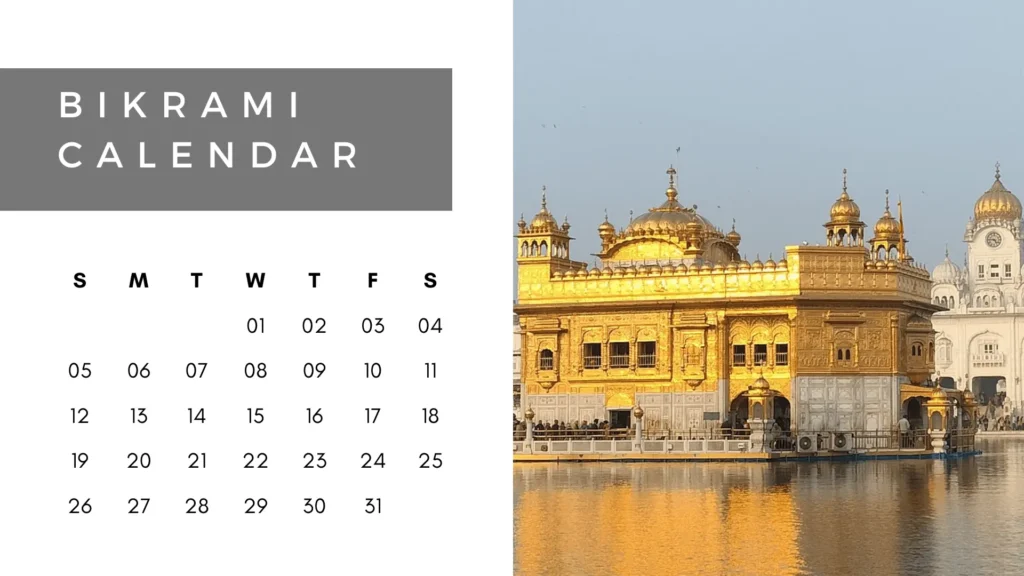Bikrami Calendar

The Bikrami calendar is the ancient Hindu calendar also used by Sikhs. In the reign of Raja Bikram Ajit, the Bikrami calendar originated and was named after this ancient Indian king. Each year in the Bikrami calendar consists of 365 days and is divided into twelve months, known as “Barah Mahinay.” Nine of these months comprise 30 days each, while one month, Vesakh, contains 31 days, and two months have 32 days. The year in the Bikrami calendar commences with the month of “Chet.” Different seasons bring different weather changes throughout the year. Each of the 12 months has its type of weather, affecting plants and nature differently. You can also find out Today’s Desi month date.
Adoption of the Bikrami Calendar by Guru Nanak Dev Ji

Guru Nanak Dev Ji has adapted the Bikrami calendar. The Bikrami calendar is a lunisolar calendar that was started in the year 57 BC. The Bikrami calendar is 57 years ahead of the English calendar that we use now.
Adoption of the Nanakshahi calendar by Sikhs
The Sikh community mainly uses the Nanakshahi calendar, but before the Nanakshahi calendar, this ancient Bikrami calendar was used by the Sikhs. It started long before Sikhism began, dating back to about 1526 years before Guru Nanak Sahib was born. However, it doesn’t wholly match everything in Sikh holy books.
Use of Bikrami Calendar in Guru Granth Sahib, Guru Gobind Singh Ji’s Banis, and Hukam Namas
We can see that Guru Sahib, Guru Nanak Dev Ji, all the Guru Sahibans, and even all the Gursikhs after Guru Gobind Singh Ji have used this Bikrami calendar, and the Bikrami system mentions many dates.
Bani of Bara Maha (Tweleve months) by Guru Nanak Dev Ji and Guru Arjun Dev Ji
Guru Nanak Dev Ji and Guru Arjun Dev Ji have written the Bani of Bara Maha in Guru Granth Sahib Ji. In this Bani, you can see that all the months mentioned are Chet, Vaisakhi, Jeth, Harh, Sawan, Bhadon, Assu, Kattak, Magghar, Poh, Magh, and Phagon. All these months are used in the Bikrami calendar.
Banis, written by Guru Gobind Singh Ji.
We can also see in the Banis written by Guru Gobind Singh Ji that they recorded the time, the days, and the month when they wrote a particular Bani or Shabad. So, one significant highlight in the Bani of Chaupi Sahib is given below.
Guru Govind Singh Ji tells us when and where he wrote the Chaupi Sahib Bani. He says it was in the year 1753, according to the Bikrami Sambhat calendar. The Bani was written in the month of Bhadon, during the waxing part of the lunar cycle, specifically on the 8th day, which was a Sunday. Guru Gobind Singh Ji also mentions that the banks of the Sutlej river completed this Grantha. The Sudhi phase is the waxing part of the lunar cycle. From here, we know that Guru Gobind Singh Ji used this reference for the Bikrami calendar.
Confusion about the year
Many people asked, 1753? But didn’t Guru Gobind Singh Ji leave this world in 1708? Yes, remember we mentioned that the Bikrami calendar is 57 years ahead of the English calendar. 1753 minus 57, you will get the year of 1696. So, in the year 1696, Guru Gobind Singh Ji completed this Bani.
Recording of Important Dates in the Bikrami calendar
In Sikh tradition, many important writings, like Hukam Namas by Guru Sahiban, Matava, and Gursikhs, are all dated using the Bikrami calendar. Even in old manuscripts of Guru Granth Sahib, you can find pictures showing Gurpurab dates using this calendar. For example, you might see “Poh Sudhi 7” written, which tells us the date in the Bikrami calendar.
The Bikrami calendar is unique because it combines both the solar and lunar cycles. There are 365 days in a solar year and 12 months in a lunar year. Each month has its name, like Chet or Vaisakhi, and days are numbered accordingly, such as Chet Vadi 13. This system helps keep track of time and essential events in Sikh history.
Addition of leap year
there is a gap or differences between the lunar cycle and the solar cycle, and it is about an 11-day gap, so what happens is that after 3 years, a leap month is added into the Bikrami calendar, just like how in the English calendar, every four years, a leap gap is added in February.
Vadi phase and the Sudhi phase in the Bikrami Calendar.
Let’s now look at the lunar cycle. Each lunar month, the days can range from about 28 days to 29, 30, and 31 days, and each lunar month is further divided into two phases, so we have the Vadi phase and the Sudhi phase.
The Vadi phase is the waning phase of the moon cycle, and the Sudhi phase is the waxing phase. So the Vadi cycle starts from the Full moon, which is “Puranmashi,” to the New Moon, which is “Masya,” and then the Sudhi cycle continues from the New Moon to Puranmashi. A Full lunar month is a cycle from one Full moon to another Full moon.
Confusion about the New Year in the Bikrami Calendar
In the Sikh calendar, the New Year starts in the month of “Chet,” so this is another confusion that the Panth causes. The Sikh New Year falls in the month of Vaisakhi on the day of Vaisakhi, which is not valid. The Sangrand means when a new day of a new month comes that is called a Sangrand the first day of a new month, so Khalsa panth was born on the day of Vaisakhi, the Sangrand of the month of Vaisakhi, but our new year falls on the Sangrand, of the month of “Chet” so our first month is the month of Chet.
Understand the Bikrami calendar system
To understand how the whole Bikrami calendar system works and how it is recorded, let’s look at a few examples that we are familiar with. Guru Gobind Singh’s Prakash Dihara recorded in the Bikrami calendar is Poh Sudhi 7 so now how do we convert this date into the English calendar so we know that the month of Poh falls from mid-December to mid-January Sudhi here means the waxing cycle of the moon cycle which means from the new moon to full moon and 7 tells us that it is the seventh day of that cycle so this year in 2021 the day of the new moon or the day of Masya falls on January 13th and adding seven days after that means that Guru Gobind Singh’s Prakash Dihara was on January 20th, 2021
the second example that many of us are familiar with is the Kattak Puranmashi, which is the Prakash Dihara of the Guru Nanak Kattak. Here is the month from mid-October to mid-November, and we know Puranmashi is the new full moon of the month of Kattak, so last year, the day of Puranmashi fell on 38th November, and this year, in 2021, guru Prakash Dihara, based on the lunar cycle, falls on November 19th. I hope that you understand how the Bikrami calendar system works, how the dates are recorded, and how they are then converted into the English calendar.
Conclusion
In simple terms, the Bikrami calendar is an integral part of Sikh tradition. Even though many Sikhs now use the Nanakshahi Calendar, the Bikrami one is still used in essential writings and events. It helps keep track of time using both the sun and the moon. While it can be a bit confusing at times, understanding it helps us connect with Sikh history and culture.
